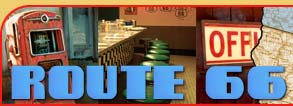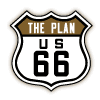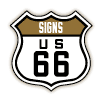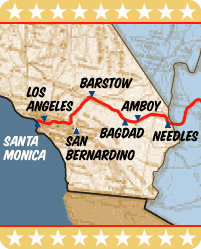 A new U.S. Route 66 could adopt the alignment of the pending Route 66 Scenic Byway in eastern California along with additional alignments in the L.A. Basin already recognized as "Historic" 66 thus providing the Route 66 traveler with an uninterrupted, continuously signed route all the way Route 66's final destination in Santa Monica.
A new U.S. Route 66 could adopt the alignment of the pending Route 66 Scenic Byway in eastern California along with additional alignments in the L.A. Basin already recognized as "Historic" 66 thus providing the Route 66 traveler with an uninterrupted, continuously signed route all the way Route 66's final destination in Santa Monica.
For millions of travelers, whether they were tourists or movers in search of a better life, the Golden State was frequently their final destination. It was the Promised Land for thousands fleeing the Dust Bowl conditions of the 1930's as immortalized by John Steinbeck in The Grapes of Wrath.
In the post WWII years, tens or even hundreds of thousands more, fled what had become known as the Frost Belt for the warmer climes and professional jobs of Southern California. More often than not, U.S. Highway 66 was their route of choice.
Many a carload of voyagers would cheer after crossing the Colorado River and seeing a wonderful sight - that of a sign proclaiming "Welcome to California". But some of the most difficult miles still lay ahead in the Mojave Desert where shade temperatures often soar to near 120 degrees. But, of course, there is no shade!
There were oases in the desert such as the famed Roy's Café in Amboy, or the Ludlow Café in its namesake town that would reach out to travelers in need. At one time, a combination filling station/restaurant/motor court/grocery store offered its services at Cadiz Summit east of Amboy. Alas, this jewel stands in ruins today.
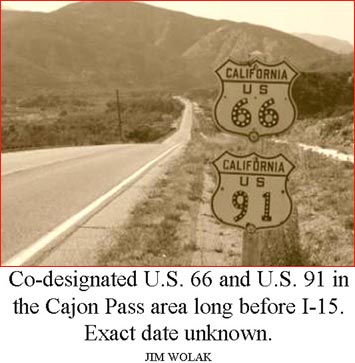 After leaving the desert behind, The Summit Café, still in business today, can be found at the top of Cajon Pass. The Summit welcomes hungry and thirsty travelers on the last leg of their journey to L.A.
After leaving the desert behind, The Summit Café, still in business today, can be found at the top of Cajon Pass. The Summit welcomes hungry and thirsty travelers on the last leg of their journey to L.A.
On the far side of the mountains, the Los Angeles Basin is home to the renowned Wigwam Motel in Rialto and that's not to forget the site of the world's first McDonald's Hamburger joint in nearby San Bernardino. What has grown into a sprawling, multi-billion dollar international corporation and a component of the Dow Jones Industrial Average can trace its corporate history back to a direct link with America's Main Street - U.S. Route 66.
Some of the most fascinating points of interest along Old Route 66 are found near the very western end of old Route. Los Angeles County sports 34 National Registered Historic Places on or within one block of Old Route 66. Los Angeles was also the original terminus of U.S. 66 until it was officially extended to Santa Monica in 1936.
Prior to its "decommissioning", the "66" U.S. Route designation ran over the historic Arroyo Seco Parkway. The Parkway passed through the Figueroa Street tunnels - the only vehicular tunnels to be found anywhere on Route 66. The Arroyo Seco Parkway has now been designated as a National Scenic Byway and is the only such Byway in the United States located in an urban setting.
Something seems sadly amiss in California since the decommissioning of U.S. 66. It's almost as though a small a part of us died with its passing. We needn't be satisfied with this sorry state of affairs. The "66" U.S. Route designation can be restored but only if enough people show that they care.
Amazingly enough, nearly 95% of the pre-Interstate era Route 66 is still drivable in California and is in good condition. Although in California the state DOT (Caltrans) has turned nearly all of the Mother Road back over to county or municipal management, much more so by far than in the other seven Route 66 states. Just in the last year or so, Caltrans decommissioned California State Route 66 between San Dimas and San Bernardino turning the roadway over to San Bernardino County.
The issue of placing new U.S. Route markers on county roads and municipal streets will need to be resolved. It would be ideal if Caltrans would take the management of these roads back, sign them and keep them signed for Route 66 but that will probably necessitate some kind of financial assistance.
There are a few areas where U.S. 66 markers will also need to be placed on I-40 and I-15 where there is no historic alignment to carry the designation but those stretches are relatively short.
Improved signage, especially at freeway exit ramps, would greatly increase tourist and leisure travel in the Victorville - Helendale - Barstow corridor and in the Mojave Desert. Exit signs at off ramps leading to "Historic" U.S. 66 could increase tourist traffic enough along old Route 66 in the Mojave Desert to possibly give older business establishments like Roy's Café a chance to thrive again.
National Scenic Byway Status was pending for the Barstow - Needles portion of the highway as of mid year 2012. The experience of the other Route 66 states has shown that Byway status will focus attention on the Route and further preservation efforts but will not provide a seamless, continuously signed route that is obviously needed. It will probably take a new U.S. Route designation to accomplish that.
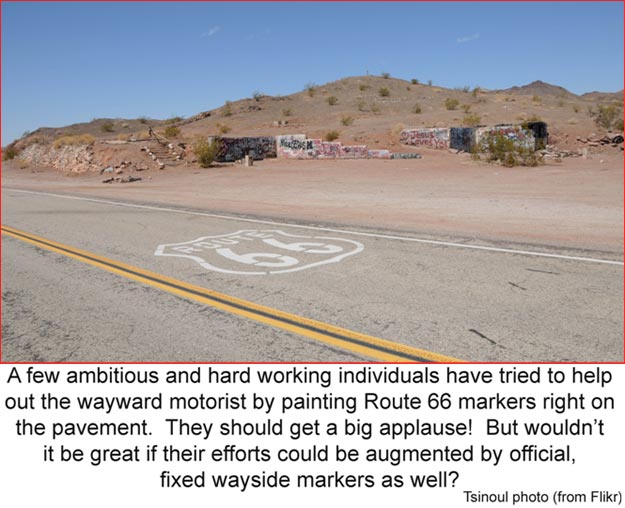
Entering the greater Los Angeles area, the new U.S. 66 could leave I-15 at the Devore exit and run out to its final destination in Santa Monica using traditional, historic alignments. In the L.A. area, most of old Route 66 has been recognized as an historic route whose alignment could be used to carry a new "66" U.S. Route designation.
In those locations where an additional, parallel alignment has been identified as an historic alignment of old Route 66, the primary alignment (to be determined by the Caltrans) would get the new U.S. Route designation while the secondary alignment could be designated as U.S. "Alternate" 66 or U.S. "Business" 66. Perhaps even the one time U.S. "Alternate" 66 designation in East L.A. could be revived. For more information see The Plan page. The U.S. Route 66 Recommissioning Initiative is a resigning proposal and not a "highway" plan. It is, after all, the SIGNS that The Initiative seeks to recommission and not a "federal highway" status.
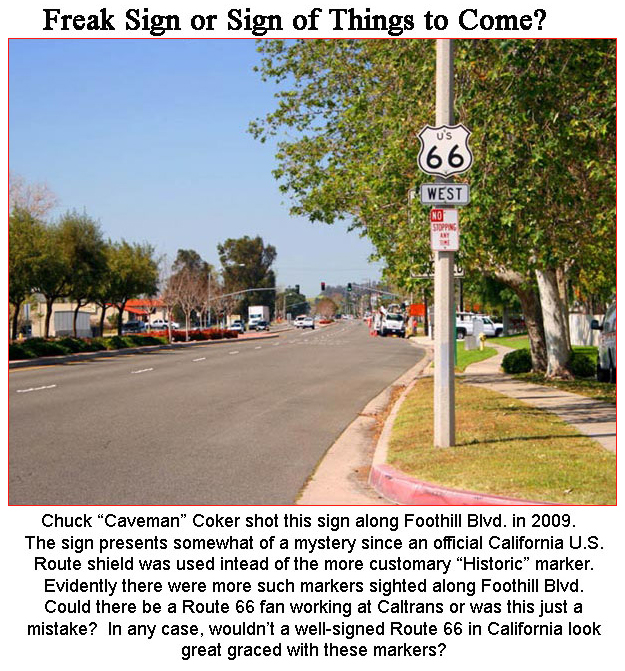
In California, all route numbers (State, U.S. and Interstate) are written into law as a part of the State's streets and highways code. A change in route numbering of this magnitude would require an act of state legislation. But that is actually an advantage for those seeking to reinstate the 66 U.S. Route designation. There is a direct channel open between state residents, their state representatives and Caltrans.
A member of the state legislature has the authority to request a formal study of a route change from CALTRANS and the ability to sponsor legislation that, if passed, would mandate it. Given the huge and growing popularity of Route 66, the measure could quite possibly pass if introduced.
If you are a resident of California and interested in the return of U.S. Route 66 find your state assembly member at http://192.234.213.69/amapsearch/ then contact him or her at: http://assembly.ca.gov/assemblymembers
Find your state senator here: http://192.234.213.69/smapsearch/framepage.asp
Contact them at: http://senate.ca.gov/senators
Urge them to pursue the re-designation of U.S. 66 in the Golden State.
Another promising possibility is Governor Jerry Brown. Governor Brown has a history of advocating promising transportation solutions and innovations. It might just well be that he would take an interest in Route 66 if given the chance.
Write to Governor Brown at: http://gov.ca.gov/m_contact.php
Also, the state-to-state control over U.S. Route numbers lies completely with the American Association of State Highway and Transportation Officials. (AASHTO). AASHTO policy clearly states that "Notwithstanding established policies, AASHTO recognizes that Congress on occasion will establish highway routes, specifying the location of the route as well as designating the route number(s) to be used".
Therefore the most ideal way to bring back Route 66 is very likely through Congressional legislation. The beauty of Congressional legislation is that a provision could be made to give Caltrans federal funds to help pay for the new U.S. Route markers.
Senator Barbara Boxer has a seat on the Senate Transportation Committee which gives the Senator a high degree of leverage on transportation issues. Senator Boxer has been trying to get a transportation reauthorization passed that would include a boost in infrastructure investment that would fix our roads, build new rail and transit lines and put people back to work all in one fell swoop. It is possible that she might be receptive to the needs of Route 66.
Contact Senator Boxer at: http://boxer.senate.gov/en/contact/policycomments.cfm
Urge the Senator to include money for new Route 66 signs in any upcoming transportation reauthorization bill along with funds to help Caltrans re-annex parts of old Route 66 that were turned back over to county management.
It would also be helpful to find and write to your representative at:
http://www.house.gov/writerep/
And now, in conclusion, we have arrived at the end of the road in Southern California. Southern California, the land of dreams - where sometimes dreams come true.
Imagine the dream of being able to turn off of Lake Shore Drive and onto East Jackson Drive in Chicago with the hood of your car pointed at Santa Monica and then look forward to a continual, constant procession of Route 66 markers all the way across three time zones and through eight states. An impossible dream? No, it is not! The only thing that would make this truly impossible is if we don't try. Never underestimate what the efforts of just a few concerned citizens can accomplish. Let's all work together to put the most famous American highway - and symbol of our American culture - back on our National road atlas. In short, BRING BACK ROUTE 66!
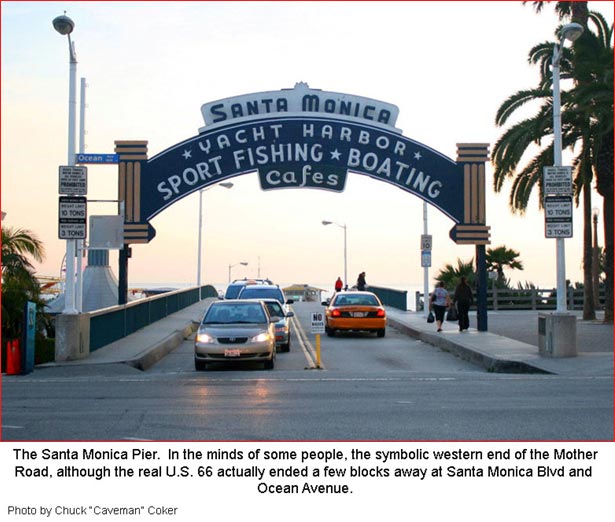
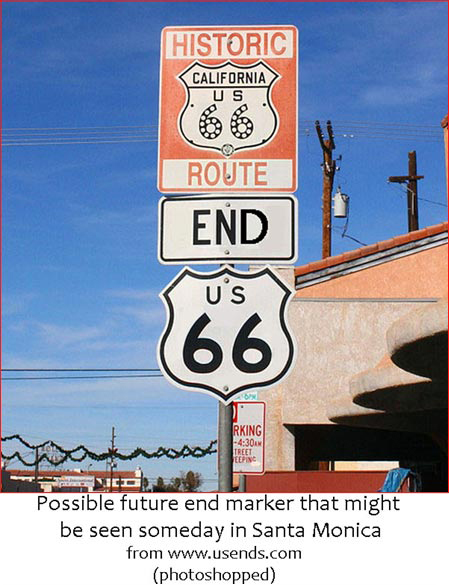
|
